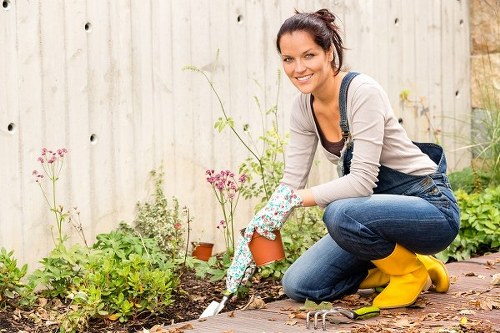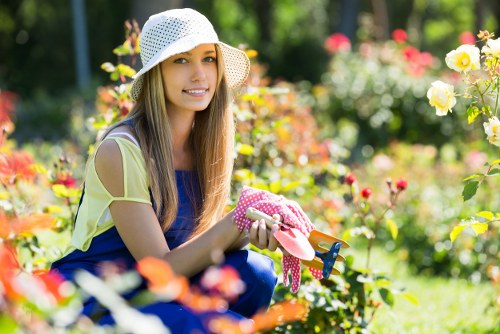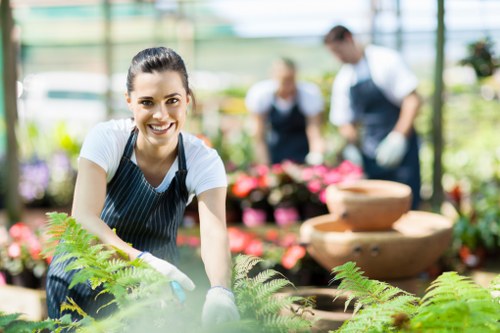Comprehensive Guide to Garden Maintenance in Wanstead

Introduction to Garden Maintenance
Maintaining a beautiful garden in Wanstead requires a blend of passion, knowledge, and regular care. Whether you’re a seasoned gardener or a novice, understanding the intricacies of garden upkeep can transform your outdoor space into a vibrant and thriving oasis.
Garden maintenance involves a variety of tasks, from pruning and weeding to soil health management and pest control. Each of these elements plays a crucial role in ensuring your garden remains healthy and aesthetically pleasing throughout the year.
In Wanstead, the climate and local flora present unique challenges and opportunities for gardeners. By tailoring your maintenance practices to suit the local environment, you can achieve optimal results and enjoy a flourishing garden all year round.

Seasonal Garden Maintenance Tips
Spring Maintenance
Spring is the perfect time to rejuvenate your garden after the winter months. Start by clearing away any debris and dead plants to make room for new growth. Pruning shrubs and trees encourages healthy development and shapes your plants for the upcoming season.
Fertilizing is essential during spring to provide your plants with the necessary nutrients. Consider using organic fertilizers to enrich the soil naturally. Additionally, planting new seeds or seedlings can add fresh colors and variety to your garden.
Regular watering is crucial as plants begin to grow. Ensure that your irrigation system is functioning correctly, and adjust your watering schedule to accommodate the increased sunlight and warmer temperatures.

Essential Tools for Garden Maintenance
Basic Gardening Tools
Having the right tools can make garden maintenance much more manageable. Some essential tools include:
- Pruning Shears: Ideal for trimming and shaping plants.
- Garden Fork: Useful for aerating soil and digging.
- Hoes: Essential for weeding and cultivating soil.
- Watering Can or Hose: Ensure consistent watering of plants.
Investing in high-quality tools can save you time and effort, making your garden maintenance tasks more efficient and enjoyable.

Pest and Disease Management
Identifying Common Garden Pests
Pests can significantly impact the health of your garden. Common garden pests in Wanstead include aphids, slugs, and caterpillars. Regular inspection of your plants can help you identify infestations early and take appropriate action.
Natural remedies and organic pesticides are effective in managing pests without harming beneficial insects. Introducing predator insects, such as ladybugs, can also help control pest populations naturally.
Maintaining healthy soil and proper plant spacing can reduce the likelihood of pest and disease outbreaks. Ensure good air circulation around your plants to prevent the spread of fungal diseases.

Soil Health and Fertilization
Improving Soil Quality
Healthy soil is the foundation of a thriving garden. Conducting a soil test can help you determine its pH level and nutrient content. Based on the results, you can amend the soil to meet the specific needs of your plants.
Incorporating organic matter, such as compost or well-rotted manure, enhances soil structure and fertility. Mulching helps retain moisture, suppress weeds, and regulate soil temperature.
Regularly adding fertilizers tailored to your garden’s requirements ensures that plants receive the necessary nutrients for robust growth and resilience against stresses.
Landscape Design and Plant Selection
Choosing the Right Plants
Selecting plants that are well-suited to Wanstead’s climate and soil conditions is crucial for successful garden maintenance. Opt for native plants, as they are adapted to the local environment and require less maintenance.
Consider the sun exposure, watering needs, and growth habits of each plant to ensure they thrive in your garden’s specific conditions. Mixing perennials with annuals can provide continuous blooms and interest throughout the seasons.
Incorporating a variety of plant types, including flowering plants, shrubs, and ornamental grasses, adds texture and depth to your garden design, making it visually appealing and dynamic.
Hardscaping and Garden Structures
Incorporating Hard Elements
Hardscaping elements, such as patios, pathways, and pergolas, complement your garden’s natural features and enhance its functionality. Well-designed pathways guide visitors through your garden, showcasing different areas and plantings.
Patios and seating areas provide spaces for relaxation and entertainment, making your garden a versatile outdoor living area. Pergolas and trellises offer support for climbing plants and add architectural interest.
Choosing durable materials and designing structures that blend seamlessly with your garden’s aesthetic ensures that hardscaping elements remain attractive and functional over time.
Regular Maintenance Schedule
Creating a Maintenance Plan
Establishing a regular maintenance schedule helps keep your garden in optimal condition. Divide tasks into daily, weekly, and monthly activities to ensure consistent care.
Daily tasks may include watering plants and inspecting for pests. Weekly activities can involve weeding, pruning, and checking soil moisture levels. Monthly tasks might include fertilizing, mulching, and deep cleaning garden tools.
Adhering to a maintenance plan prevents tasks from piling up and ensures that your garden remains healthy and vibrant throughout the year.
Eco-Friendly Garden Practices
Sustainable Gardening Techniques
Incorporating eco-friendly practices into your garden maintenance reduces environmental impact and promotes sustainability. Implementing rainwater harvesting systems can provide a natural water source for your plants, conserving water resources.
Using organic fertilizers and pest control methods minimizes the use of harmful chemicals, protecting beneficial insects and soil health. Composting garden waste recycles nutrients back into the soil, enhancing its fertility.
Choosing native plants and creating habitats for wildlife fosters biodiversity and supports local ecosystems, making your garden a haven for various species.
Professional Garden Maintenance Services
When to Hire Experts
While DIY garden maintenance can be rewarding, certain tasks may require the expertise of professional gardeners. Hiring experts ensures that complex maintenance activities, such as tree trimming, soil testing, and pest management, are carried out effectively and safely.
Professional services can provide tailored maintenance plans based on your garden’s specific needs, optimizing plant health and garden aesthetics. They also offer valuable advice and insights to help you improve your gardening practices.
Investing in professional garden maintenance services can save you time and effort, allowing you to enjoy a beautifully maintained garden without the stress of managing all tasks on your own.
Conclusion
Effective garden maintenance in Wanstead involves a combination of regular care, informed practices, and the right tools. By understanding the unique aspects of your local environment and implementing sustainable methods, you can create and maintain a thriving garden that enhances the beauty of your outdoor space.
Whether you choose to undertake maintenance tasks yourself or enlist the help of professional services, dedication and consistency are key to achieving a lush and vibrant garden. Embrace the joys of gardening and transform your Wanstead garden into a picturesque retreat that you can enjoy all year round.
Ready to transform your garden?
Contact us today to book your garden maintenance service and experience the difference a well-maintained garden can make!